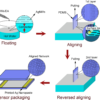The physical laws of everyday water flow were established two centuries ago. However, scientists today struggle to simulate disrupted water flow virtually, e.g., when a hand or object alters its flow.
Now, a research team from Tohoku University has harnessed the power of deep reinforcement learning to replicate the flow of water when disturbed. Replicating this agitated liquid motion, as it is known, allowed them to recreate water flow in real time based on only a small amount of data from real water. The technology opens up the possibility for virtual reality interactions involving water.
Details of their findings were published in the journal ACM Transactions on Graphics.
Crucial to the breakthrough was creating both a flow measurement technique and a flow reconstruction method that replicated agitated liquid motion.
To collect flow data, the group—which comprised researchers from Tohoku University’s Research Institute of Electrical Communication (RIEC) and the Institute of Fluid Science—placed buoys embedded with special magnetic markers on water. The movement of each buoy could then be tracked using a magnetic motion capture system. Yet this was only half of the process. The crucial step involved finding an innovative solution to recovering the detailed water motion from the movement of a few buoys.
“We overcame this by combining a fluid simulation with deep reinforcement learning to perform the recovery,” says Yoshifumi Kitamura, deputy director of RIEC.
Reinforcement learning is the trial-and-error process through which learning takes place. A computer performs actions, receives feedback (reward or punishment) from its environment, and then adjusts its future actions to maximize its total rewards over time, much like a dog associates treats with good behavior. Deep reinforcement learning combines reinforcement learning with deep neural networks to solve complex problems.
First, the researchers used a computer to simulate calm liquid. Then, they made each buoy act like a force that pushes the simulated liquid, making it flow like real liquid. The computer then refines the way of pushing via deep reinforcement learning.

A flowchart of the digital replication process. An unknown disturbance is introduced to the water. For example, a person is randomly waving a plastic bunny underwater. Buoys are floated to measure the water flow. The movement of the buoys is used to replicate the original flow digitally. © Kinfung Chu et al.
Previous techniques had typically tracked tiny particles suspended inside the liquid with cameras. But it still remained difficult to measure 3-D flow in real-time, especially when the liquid was in an opaque container or was opaque itself. Thanks to the developed magnetic motion capture and flow reconstruction technique, real-time 3-D flow measurement is now possible.
Kitamura stresses that the technology will make VR more immersive and improve online communication. “This technology will enable the creation of VR games where you can control things using water and actually feel the water in the game. We may be able to transmit the movement of water over the internet in real time so that even those far away can experience the same lifelike water motion.”
More information:
Kinfung Chu et al, Real-Time Reconstruction of Fluid Flow under Unknown Disturbance, ACM Transactions on Graphics (2023). DOI: 10.1145/3624011
Citation:
Let it flow: Recreating water flow for virtual reality (2023, September 20)



